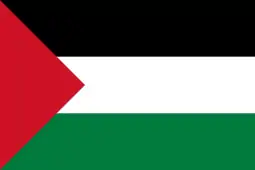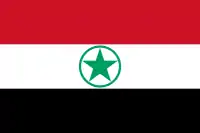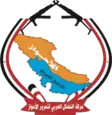Arab Struggle Movement for the Liberation of Ahvaz
The Arab Struggle Movement for the Liberation of Ahwaz (Arabic: حركة النضال العربي لتحرير الأحواز, romanized: ḥarakat an-nidhāl al-arabiː litaħriːr al-aḥwāz; abbreviated ASMLA) is an Arab nationalist and separatist insurgent group which advocates the secession of Khuzestan Province from Iran and the establishment of an Arab state, a goal which it is attempting to achieve by waging a direct and violent conflict against Iran.[1]
| Arab Struggle Movement for the Liberation of Ahvaz | |
|---|---|
Flag Seal | |
| Founding leader | Ahmad Mola Nissi (KIA) |
| Leaders |
|
| Spokesperson | Yaqoub al-Tostari |
| Dates of operation | 2005–present |
| Group(s) |
|
| Headquarters | |
| Active regions | Khuzestan Province, Iran |
| Ideology | |
| Size | 300 (unconfirmed estimate) |
| Battles and wars | Arab separatism in Khuzestan |
| Designated as a terrorist group by | |
Headquartered in Denmark and the Netherlands, ASMLA has claimed responsibility for several assassinations, attacks against energy infrastructure and civilian soft targets,[2] including 2005–06 Ahvaz bombings and Ahvaz military parade attack in 2018.
It is classified as a terrorist organization by the Iranian government.
History
In 1999,[3] Habib Yabar, Habib Asewad Kaabi and Ahmad Mola Nissi established the ASMLA in Europe, financed and sponsored by Saudi Arabia.[4]
In September 2012, head of the ASMLA met Mohammad Riad al-Shaqfeh, his counterpart in the Muslim Brotherhood of Syria, indicating a potential cooperation between the two organizations.[5]
On 30 October 2018, the Danish Security and Intelligence Service (DSIS) accused "Iran of plotting assassination on Danish soil",[6] planning to kill the leader of ASMLA, who lives there. The threat of an assassination was the source of a country-wide police action in Denmark on 28 September. DSIS announced that three persons related to ASMLA are under police protection, and that there still is an active threat.[7][8] Iran dismissed the accusations.[9]
Organization
According to Casey Donahue, since 2007 the group has operated in two headquarters located in Denmark and the Netherlands, but in October 2015 the ASMLA experienced a schism.[10] Both Dutch and Danish factions use the same name and flag, and continue to claim they control the 'Martyrs Brigade', ASMLA's military wing.[10]
Leadership
The Danish faction is based in Copenhagen and led by Habib Jaber al-Ka'abi (born c. 1969/1970 (age 50–51),[11] a.k.a. Habib Jabor).[12] He was a teacher and principal in schools of Ahvaz and immigrated to Denmark in the mid-1990s.[11] al-Ka'abi holds Danish citizenship and is under full protection of Denmark's security services.[11]
The founding leader of the Dutch faction based in The Hague was Ahmad Mola Nissi, who was killed in November 2017.[10] Nicholas A. Heras wrote in 2019 that after Nissi's death, al-Ka’abi is the sole leader of ASMLA,[11] however Casey Donahue maintains that Nissi was succeeded by Saddam Hattem in June 2018.[10]
In October 2020, Iran arrested a leader of the group named Habib Asyud (a.k.a. Farajollah Cha'ab),[13] who was based in Sweden and holds Swedish citizenship, reportedly in Turkey.[14] after he was lured by a female agent.[15]
Ideology
| Part of a series on |
| Baathism |
|---|
 |
|
ASMLA's profile on Terrorism Research & Analysis Consortium repository[16] and a piece published by the Jamestown Foundation in 2011[17] suggest that the group is Ba'athist, the latter also mentioning that in 2007 it had recognized Izzat Ibrahim al-Douri as the successor of Saddam Hussein and the new leader of the Iraqi Ba’ath party.[17]
The group refers to Iran as the "Persian enemy"[18] and says that it wants to "liberate Ahwaz lands and people from the Iranian occupation".[19] It pictures the territory of its proposed state to be beyond Khuzestan Province borders, including Zagros Mountains and the northern coasts of the Persian Gulf.[10]
Hamid Dabashi, professor of Iranian Studies at Columbia University, who was born and raised in Ahvaz, states that it is a cosmopolitan and pluralist city with people from different ethnic backgrounds, while the separatists make an exclusive and absolutist claim on the city due to a "decidedly racialised, ethnicised" and "narrow-minded ethno-nationalist" ideology.[20]
Military wing
The military wing of ASMLA is named Mohiuddin Nasser Martyrs Brigade (MMDNB).[16] It kept a low profile between 2006 and 2011.[10] In 2019, an analyst affiliated with the group told the Jamestown Foundation that the military wing of the ASMLA has about 300 members operating inside Iran,[10] but there is no independent verification for this number. The following cells has been named in the group's statements as part of the military wing:
- Majid al-Baghbeh Martyrs Battalion
- Razi al-Zarqani Martyrs Battalion
- al-Farouq Battalion
Timeline of attacks
- 2005
- June 12: ASMLA claimed responsibility for a series of four bomb explosions in Ahvaz.[21] One of the bombs was concealed in a briefcase outside a residential area and was exploded when authorities were moving it to a secure area, while one blew up the governor's office and the other two were in public buildings. The bombings collectively killed at least 8 people and left some 75 wounded, including women and children.[22]
- 2006
- January 24: Bombs were blown up in a branch of Saman Bank in Kianpars neighborhood of Ahvaz, as well as the city's natural resources government office, killing at least 8 people and injuring 46 other, including staff and clients in the bank.[23] The ASMLA claimed responsibility for the killings by issuing a statement, saying "[o]ur heroes... in the military wing of The Arab Struggle Movement for the Liberation of Ahvaz attacked and destroyed the dens of the occupying enemy".[24]
- 2012
- October 23: A gas pipeline facility near Shush was exploded and the ASMLA took responsibility for the attack.[25]
- 2013
- November 27: The group announced that its Majid al-Baghbeh Martyrs Battalion of the Mohiuddin al-Nasser Martyrs Brigade has conducted attacks on natural gas pipelines running from Shadegan and Sarbandar.[2]
- 2015
- May 14: ASMLA bombed a government office in Susangerd.[26]
- September 3: An oil installation in Arjan was attacked.[26]
- 2016
- January 2: An attack on a pipeline north of Ahvaz was claimed to have been conducted by the Battalion of Martyr Razi Zarqani.[26]
- June 14: The group claimed its Battalion of Martyr Razi Zarqani has "crippled the flow of oil from Ahvaz toward Tehran" in Zarqan.[26]
- July 17: ASMLA declared its al-Farouq Battalion has targeted oil pipelines in Haftkel County and claimed that the perpetrators have successfully escaped Iranian forces.[27]
- 2017
- January 2: The group claimed to have caused major damages to petroleum pipelines of Marun Field and those from the Baharkan oilfield to Kharg Island. A spokesman for the Iranian interior ministry denied this.[28]
- January: ASMLA claimed responsibility for killing two servicemen in the Islamic Revolutionary Guard Corps.[19]
- 2018
- February 26: ASMLA claimed it had bombed oil facilities.[29]
- 22 September: Four assailants disguised in IRGC uniforms attacked a military parade in Ahvaz, killing 29 and wounding 70 people, including civilians. ASMLA claimed responsibility for the attack, which was also claimed by the Islamic State of Iraq and the Levant (ISIL).[30] ASMLA later denied involvement, after Iranian foreign ministry summoned the ambassadors of Denmark and the Netherlands in Tehran in protest for hosting the group.[31]
Terrorist designation
Iran designates ASMLA as a terrorist organization.[32] As of January 2021, no other country has officially listed the organization.
In February 2020, Dutch police arrested one ASMLA member in Delft for membership of a terrorist organization and suspicion of planning terrorist attacks inside Iran, despite the fact the European Union does not consider ASMLA a terrorist group.[33] Earlier, three suspected ASMLA members had been arrested in November 2018 by Police of Denmark, which announced they were "suspected of violating the Danish law... on condoning terrorism".[34]
Foreign sponsorship
Iran has accused Saudi Arabia of supporting the group, which the Saudis have rejected.[12]
Finn Borch Andersen, chief of the Danish Security and Intelligence Service (PET), told the press in February 2020 that his agency had arrested three members of the ASMLA who have been spying for a Saudi Arabian intelligence service in Denmark from 2012 to 2018.[35]
In November 2020, Iranian Ministry of Intelligence published what it said was secret correspondence between ASMLA and the Saudi intelligence agency General Intelligence Presidency.[36]
Nazanin Soroush, writing in a April 2015 issue of Jane's Intelligence Weekly, comments that ASMLA is likely to receive foreign support from Iran's opponents, and act as a proxy.[5] Rasmus Christian Elling of the University of Copenhagen suggests that the group has probably received support from Saudi Arabia and the United Arab Emirates, stating "there are certain indications that groups such as ASMLA are receiving support, either from private individuals or state institutions in Gulf countries. It would be interesting, for example, to know how they can afford to launch TV stations with brand new equipment in places such as the Netherlands and Denmark".[37]
See also
References
- Burnett, M. Troy, ed. (2020), Nationalism Today: Extreme Political Movements around the World, ABC-CLIO, p. 372, ISBN 9781440850004,
The Arab Struggle Movement for the Liberation of Ahwaz and its military wing, Mohiuddin al Nasser Martyrs Brigade, advocate for a separate Arab state. One of its tactics includes direct, violent conflict with Iranian security.
- Zambelis, Chris (23 January 2014), "The Struggle for Arabistan: Tensions and Militancy in Iran's Khuzestan Province", Terrorism Monitor, The Jamestown Foundation, 12 (2), retrieved 1 November 2020
- Adil Alsalmi. "Liberation of Ahwaz Movement Leader: The Deceive Storm restored faith to our hearts". Asharq Al-Awsat. Archived from the original on 2017-10-12.
- Hurtado, Luis Miquel (23 September 2018). "Al Ahvaziya: el independentismo árabe amenaza a Irán desde Europa". El Mundo (in Spanish). Archived from the original on 23 September 2018.
- Soroush, Nazanin (22 April 2015), "Iran's increasingly active involvement in the region's proxy wars increases domestic separatist terrorism risk", Jane's Intelligence Weekly, Jane's Information Group, 7 (20), ISSN 2040-8315
- Dehghan, Saeed Kamali (October 30, 2018). "Denmark pushes for fresh Iran sanctions over 'assassination plot'" – via www.theguardian.com.
- "Iransk efterretningstjeneste planlægger attentat på dansk grund". Berlingske.dk (in Danish). 2018-10-30. Retrieved 2018-10-30.
- "PET-chef: Iransk efterretningstjeneste planlagde attentat i Danmark". DR (in Danish). Retrieved 2018-10-30.
- McKirdy, Euan. "Denmark accuses Iran of political 'assassination plot' on its soil". CNN.
- Donahue, Casey (2 July 2020), "Profiles: Iranian Opposition Groups", The Iran Primer, Woodrow Wilson International Center for Scholars and the U.S. Institute of Peace, retrieved 1 November 2020
- Heras, Nicholas A. (May 2019), "Iran's High Value Target in Europe—Habib Jaber al-Ka'abi" (PDF), Militant Leadership Monitor, The Jamestown Foundation, X (5): 4–6
- Rasmussen, Sune Engel (25 November 2018), "Dissidents Call for United Front Against Iran After Assassination Attempts", The Wall Street Journal, retrieved 17 July 2020
- "Iran arrests separatist leader accused of attack killing 25", The Associated Press, 12 November 2020, retrieved 20 November 2020
- Jedinia, Mehdi (15 November 2020), "Iran Arrests Arab Opposition Activist Habib Chaab", Voice of America, retrieved 20 November 2020
- "Habib Chaab: Files show how Iranian dissident was kidnapped in Turkey after 'honeytrap by Iran'". Sky News. 17 December 2020.
- "Arab Struggle Movement for the Liberation of Ahvaz - Iran (ASMLA)", Terrorism Research & Analysis Consortium, retrieved 3 November 2020
- "Iraqi Militants Encourage People of Khuzestan to Launch Jihad against Iran", Terrorism Monitor, Jamestown Foundation, 9 (37), 14 October 2011, retrieved 3 November 2020 – via Refworld
- Coles, Isabel (15 August 2013), Peter Graff (ed.), "Insight: Iran's Arab minority drawn into Middle East unrest", Reuters, retrieved 3 November 2020
- Deutsch, Anthony; Sharafedin, Bozorgmehr (9 November 2017), "Iranian political activist shot dead in Netherlands", Reuters, retrieved 1 November 2020
- Dabashi, Hamid (25 September 2018), Is it Ahvaz or Ahwaz – and what difference does it make?, Al Jazeera, retrieved 3 November 2020
- "Timeline: Ethnic violence in Iran", BBC Monitoring, 24 September 2018, retrieved 1 November 2020,
2005:... The Arab Struggle Movement for the Liberation of Ahvaz claimed responsibility for a number of attacks, including the four bombings on 12 June.
- Fathi, Nazila (13 June 2005), "7 Bombings Shatter Iran's Pre-Election Calm, Killing 10", The New York Times, retrieved 1 November 2020
- Esfandiari, Golnaz; Fatemi, Hamid (24 January 2006), "Iran: President Cancels Trip As Explosions Rock Southern City", Radio Free Europe/Radio Liberty, retrieved 1 November 2020
- "Iran sees British hand in bombings", Reuters, Al-Jazeera, 25 January 2006, retrieved 1 November 2020
- Braude, Joseph (12 November 2012), "Saudis' Proxy War Against Iran", Tablet Magazine, retrieved 1 November 2020
- Szakola, Albin (17 June 2016), "Arab separatists claim attack on Iran pipeline", NOW News, Beirut, retrieved 1 November 2020
- Segall, Michael (24 July 2016), "Ethnic Opposition to Iran's Regime Is on the Rise", Jerusalem Issue Briefs, Jerusalem Center for Public Affairs, 16 (12)
- Aboudi, Sami (4 January 2017), Raissa Kasolowsky (ed.), "Arab separatists in Iran say attacked pipelines in west, Tehran issues denial", Reuters, retrieved 1 November 2020
- O'Connor, Tom (27 February 2018), "Iran Claims It Is 'Safest Country in Region' Despite U.S. Sanctions, Terrorism and Protests", Newsweek, retrieved 1 November 2020,
The Mohiuddin Nasser Brigades, the military wing of the Arab Struggle Movement for the Liberation of Ahwaz, claimed Monday bombings at oil fields in eastern Iran.
- "Chronology: Iran", The Middle East Journal, Washington DC: Middle East Institute, 73 (1): 122–124, Spring 2019, ISSN 0026-3141
- "Khamenei appears to point finger at IS for Ahvaz attack", Al-Monitor, 25 September 2018, retrieved 1 November 2020
- Bashir, Nada; McKirdy, Euan; Fox, Kara (October 31, 2018), "Denmark arrests suspect over Iranian 'assassination' plot", CNN, retrieved 3 November 2020
- "Man arrested in Delft, accused of planning terrorist attack in Iran", DutchNews, 3 February 2020, retrieved 20 November 2020
- Kamali Dehghan, Saeed (7 November 2018), "Three held in Denmark over interview praising terrorist attack in Iran", The Guardian, retrieved 20 November 2020
- "Denmark arrests three members of Iranian opposition group on spy charges", Reuters, 3 February 2020, retrieved 20 November 2020
- "Iran publishes documents showing separationist group's connection with Saudis", Islamic Republic News Agency, 18 November 2020, 84114558, retrieved 20 November 2020
- Esfandiari, Golnaz (28 September 2018), "Poverty, Separatism, And Bloody Memories Of War: Why Iran's Khuzestan Matters", Radio Free Europe/Radio Liberty

